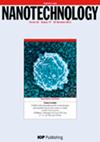Heteroatom doped graphitic carbon nanotubes as freestanding anodes for advanced potassium-ion batteries.
IF 2.8
4区 材料科学
Q3 MATERIALS SCIENCE, MULTIDISCIPLINARY
引用次数: 0
Abstract
Owing to its higher earth element reserve and similar chemical properties to lithium, potassium ion batteries (PIBs) have been regarded as a potential alternative to lithium-ion batteries. And considering the relatively larger ionic radius of potassium, available electrode materials need to be equipped with enough space for volume expansion during charge-discharge cycles, thus graphitic carbon nanomaterials with adjustable layer spacing gradually come into researcher's version. Here with copper nanowires serving as growth template and organic polyvinyl pyrrolidone (PVP) providing carbon source, freestanding and ultra-light graphitic carbon nanotube (GCNT) aerogels were simply assembled and annealed, which were directly used as anodes of PIBs. Annealing parameters (temperature and atmosphere) were adapted to regulate the lattice order and interlayer spacing of GCNTs, and N, O heteroatoms derived from PVP were directly doped into the carbon lattice during thermal annealing, to optimize and enhance the cycle capacity and rate performance of GCNT anodes. The electrochemical potassium storage mechanism of GCNTs was also quantitatively analyzed. Most of the potassium ions are reversibly stored by squeezing into and escaping from the carbon lattice, and simultaneously oxygen-containing functional groups with different chemical states also offer active redox sites and dedicate partial capacity. Therefore, our assembled GCNTs with large lumen are expected to sandwich-like load with active substances efficiently, further constructing next-generation PIBs with excellent performance.掺杂杂原子的石墨碳纳米管作为先进钾离子电池的独立阳极。
由于钾的地球元素储量较高且化学性质与锂相似,钾离子电池(PIB)一直被视为锂离子电池的潜在替代品。考虑到钾的离子半径相对较大,现有的电极材料需要为充放电循环过程中的体积膨胀提供足够的空间,因此层间距可调的石墨碳纳米材料逐渐进入研究人员的视野。本研究以纳米铜线为生长模板,以有机聚乙烯吡咯烷酮(PVP)为碳源,简单地组装和退火了独立的超轻石墨碳纳米管(GCNT)气凝胶,并将其直接用作 PIB 的阳极。通过调整退火参数(温度和气氛)来调节石墨碳纳米管的晶格阶数和层间距,并在热退火过程中直接在碳晶格中掺入由 PVP 衍生的 N、O 杂原子,从而优化和提高石墨碳纳米管阳极的循环容量和速率性能。研究还定量分析了 GCNT 的电化学钾储存机理。大部分钾离子通过挤入碳晶格和从碳晶格中逸出的方式可逆地储存起来,同时不同化学状态的含氧官能团也提供了活跃的氧化还原位点并贡献了部分容量。因此,我们组装的具有大内腔的 GCNT 可望有效地夹载活性物质,进一步构建性能优异的下一代 PIB。
本文章由计算机程序翻译,如有差异,请以英文原文为准。
求助全文
约1分钟内获得全文
求助全文
来源期刊

Nanotechnology
工程技术-材料科学:综合
CiteScore
7.10
自引率
5.70%
发文量
820
审稿时长
2.5 months
期刊介绍:
The journal aims to publish papers at the forefront of nanoscale science and technology and especially those of an interdisciplinary nature. Here, nanotechnology is taken to include the ability to individually address, control, and modify structures, materials and devices with nanometre precision, and the synthesis of such structures into systems of micro- and macroscopic dimensions such as MEMS based devices. It encompasses the understanding of the fundamental physics, chemistry, biology and technology of nanometre-scale objects and how such objects can be used in the areas of computation, sensors, nanostructured materials and nano-biotechnology.
 求助内容:
求助内容: 应助结果提醒方式:
应助结果提醒方式:


